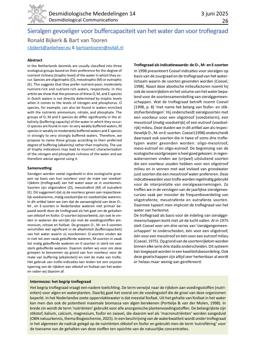2025
Sieralgen gevoeliger voor buffercapaciteit van het water dan voor trofiegraad
Publication
Publication
Desmidiologische Mededelingen , Volume 14 p. 26- 37
In the Netherlands desmids are usually classified into three ecological groups based on their preference for the degree of nutrient richness (trophic level) of the water in which they occur. Species are oligotrophic (O), mesotrophic (M) or eutrophic (E). This suggests that they prefer nutrient-poor, moderately nutrient-rich and nutrient-rich waters, respectively. In this article we show that the presence of these O, M, and E species in Dutch waters is not directly determined by trophic levels when it comes to the levels of nitrogen and phosphorus. O species, for example, can also be found in waters enriched with the nutrients ammonium, nitrate, and phosphate. The groups of O, M and E species do differ significantly in the alkalinity (buffering capacity) of the water in which they occur: O species are found in non- to very weakly buffered waters, M species in weakly to moderately buffered waters and E species in strongly to very strongly buffered waters. Therefore, we propose to name these groups according to their preferred degree of buffering (alkalinity) rather than trophicity. The use of trophy indications may lead to incorrect characterization of the nitrogen and phosphate richness of the water and we therefore advise against using it.
| Additional Metadata | |
|---|---|
| , , , | |
| Desmidiologische Mededelingen | |
| CC BY 4.0 NL ("Naamsvermelding") | |
| Organisation | Nederlandse Sieralgenwerkgroep |
|
R. Bijkerk, & B.F. van Tooren. (2025). Sieralgen gevoeliger voor buffercapaciteit van het water dan voor trofiegraad. Desmidiologische Mededelingen, 14, 26–37. |
|
